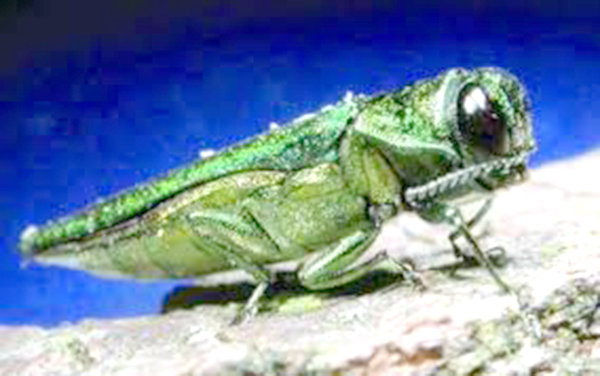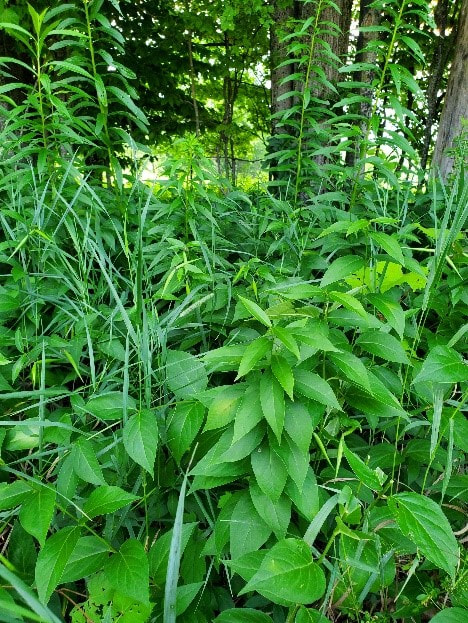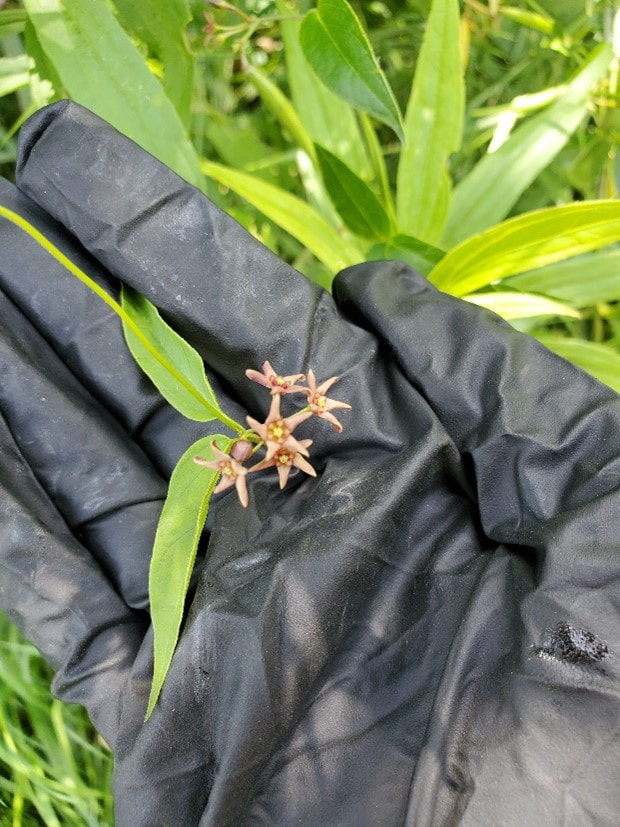INVASIVE SPECIES ALERT
Be on the lookout for these invasive species!
Black Swallow-wort (Vincetoxicum nigrum)
|
EMERALD ASH BORER ON YOUR FARM
Emerald Ash Borer (EAB)From the DEC
The emerald ash borer (EAB) (Agrilus planipennis) is an invasive beetle from Asia that infests and kills North American ash species (Fraxinus sp.) including green, white, black and blue ash. All of New York's native ash trees are susceptible to EAB. EAB Identification The emerald ash borer is a very small but very destructive beetle. It has four life stages: adult, egg, larva and pupa. The adult beetle has a shiny emerald green body with a coppery red or purple abdomen. Adult beetles leave distinctive D-shaped exit holes in the outer bark of the branches and the trunk. Adults are roughly 3/8 to 5/8 inch long with metallic green wing covers and a coppery red or purple abdomen. The adults may be seen from late May through early September but are most common in June and July. Signs of Damage Signs of infestation in the tree canopy include dieback, yellowing, and browning of leaves. S-shaped larval galleries may be visible as an infested tree's bark falls off or is removed. Increased woodpecker activity is often the first sign of an EAB infestation. This activity can lead to "blonding", or large strips of bark falling off. On the trunk and branches, look for small, D-shaped holes that are left by emerging beetles. When the tree's bark splits or falls off, S-shaped larval galleries may be visible. Most trees die within 2 to 4 years of becoming infested. How EAB Spread Adult EABs typically fly less than ½ mile from their emergence tree. Most long-distance movement of EAB has been directly traced to ash firewood or ash nursery stock. Other untreated ash wood, wood chips greater than one inch, and ash product movement (logs, lumber, pallets, etc.) generally present lesser risks. Wood chips less than one inch or mulch are considered to pose little risk of movement. New York State currently has a regulation restricting the movement of firewood to protect our forests from invasive pests. New York State Locations The first infestation of emerald ash borer (EAB) in New York State was discovered in Cattaraugus County in 2009. As of the summer of 2022, the presence of EAB has been confirmed in all New York counties except: Essex, Hamilton, and Lewis. DEC works with partners such as NYC Parks and Cornell Cooperative Extension to detect and confirm new infestations across the state. Current EffortsWhile DEC is still collecting new EAB location information, we are not actively managing infestations. New York has a regulation to restrict the movement of firewood of any tree species to within 50 miles of its source or origin. If you must move ash wood that is not firewood, be sure to follow DEC's guidelines on moving ash wood responsibly. The firewood regulation remains unchanged and in effect despite the changing or lifting of any EAB quarantines. EAB is listed as a prohibited invasive species by 6 NYCRR Part 575. Under this regulation, no person shall sell, import, purchase, transport, introduce or propagate, or have the intent to take any of these actions on the regulated species, unless issued a permit by DEC for research, education, or other approved activity. DEC is also cooperating in efforts to identify potentially resistant "lingering ash" trees (leaves DEC website) in areas thoroughly infested with EAB, and to conserve ash seed (leaves DEC website) for future restoration efforts. What to Do if You Have Found EAB A D-shaped exit hole from an EAB.Visit our webpage on EAB Recommendations and Resources for information on ash tree identification, insecticide options, and other resources for landowners, municipalities, and the wood products industry. If you confirm your tree is infested with EAB, you do not have to take it down unless the tree could pose a hazard by falling (check for nearby structures, roads, etc.). DEC can confirm if the signs of tree damage are from EAB and provide tree removal information, but unfortunately there are no DEC programs to assist landowners with tree removal. If you choose to have a tree removed, we suggest visiting our tips for selecting an arborist or tree service for guidance. How to Report a New Infestation LocationAfter reviewing the identification material on this website, if you think you have found EAB and are outside of the counties known to already have infestation areas in New York State:
Importance of AshAsh is a very common street tree in many New York communities. It was widely planted to replace native elms lost to Dutch elm disease. In Michigan, the first state in the U.S. infested with EAB, the greatest economic impact has been on communities faced with removal of thousands of dead ash on streets and in yards. Many of these dead trees pose significant public safety hazards and liability problems for municipalities. Ash seeds are a food source for birds and mammals. Ash species (white, green and black) comprise almost 8% of all trees in NY State. Ash is a commercially-valuable species, and is used for baseball bats, flooring, furniture, lumber, and pallet manufacture. Black ash is also prized by Native American tribes, including the Akwesasne, for traditional basket making. The estimated annual contribution of forest-based manufacturing and forest related recreation and tourism to the New York State economy is over $9 billion. |

